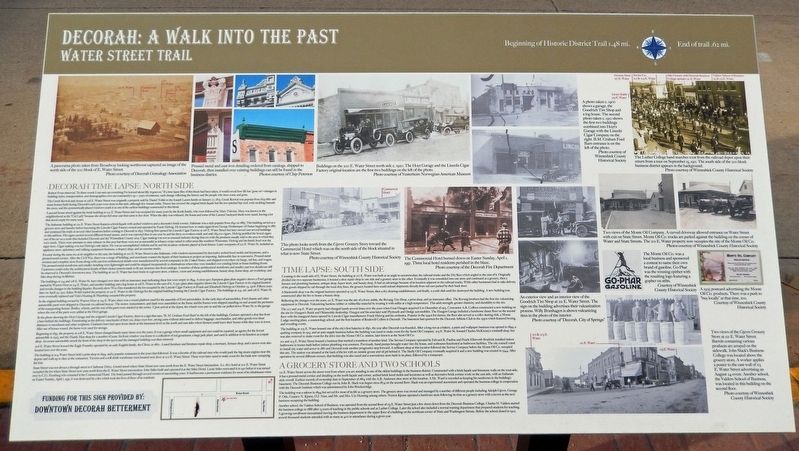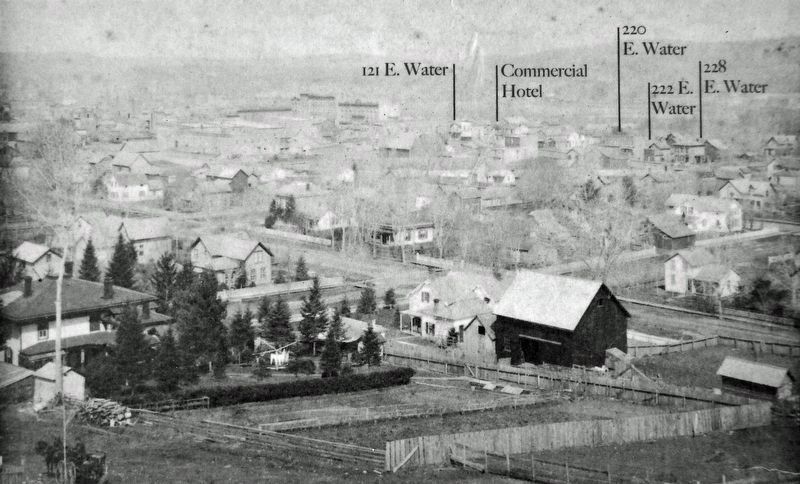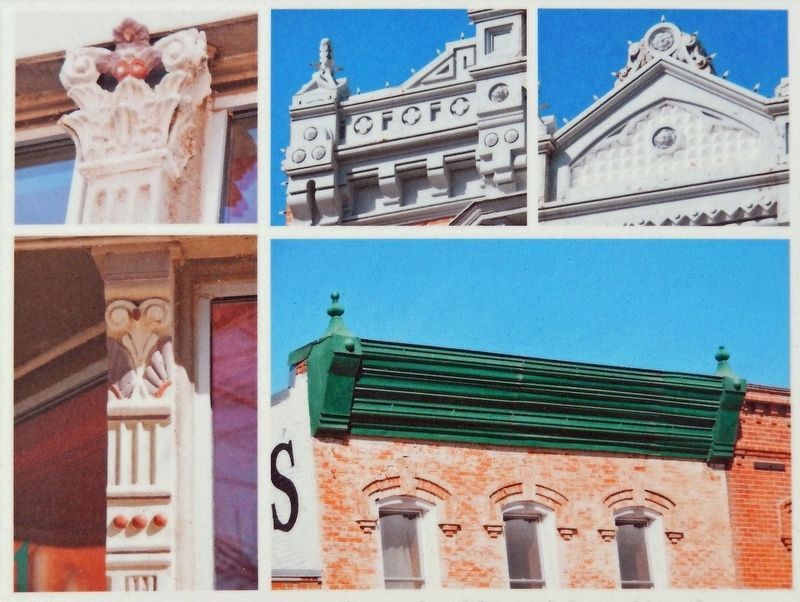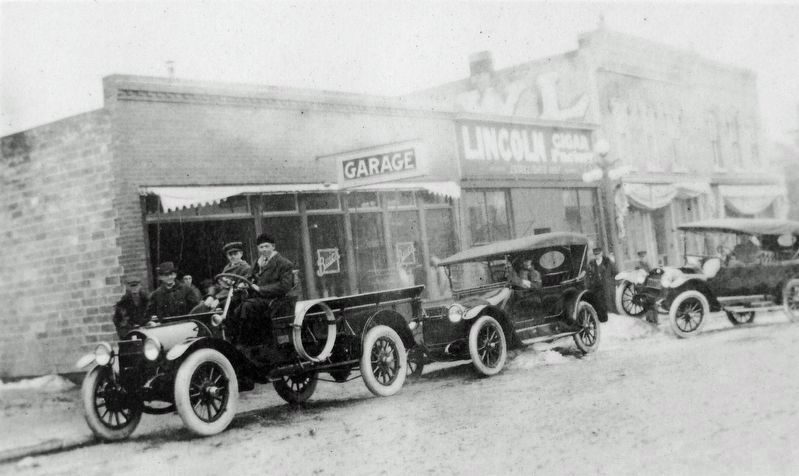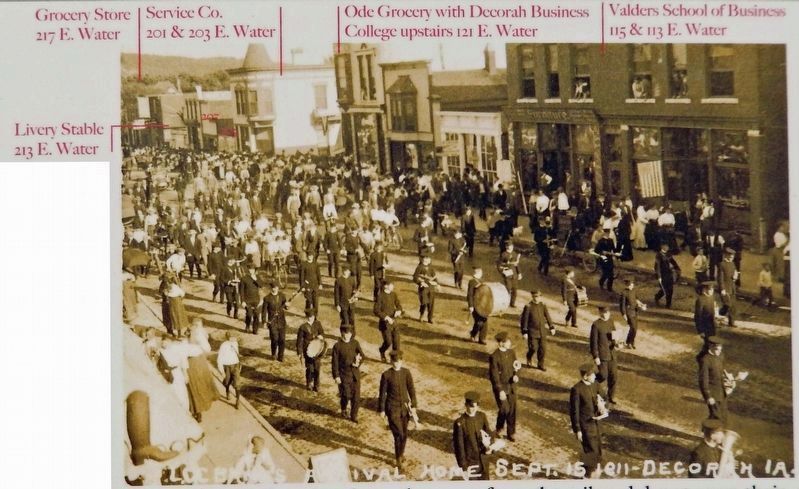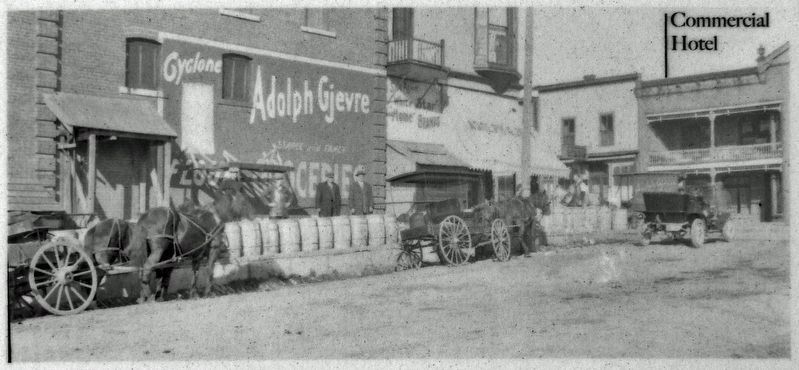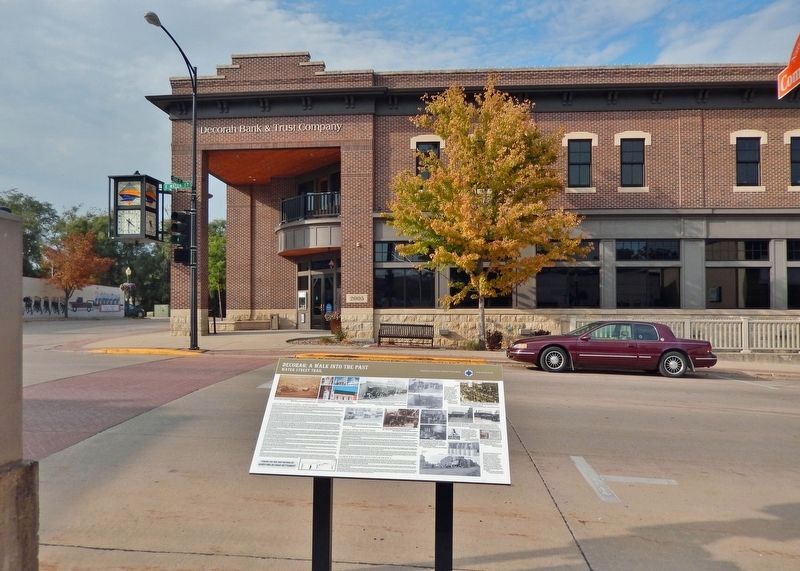Decorah in Winneshiek County, Iowa — The American Midwest (Upper Plains)
Decorah: A Walk into the Past
Water Street Trail
Decorah Time Lapse: North Side
Robert Frost observed, “In three words I can sum up everything I've learned about life: it goes on.” If a time lapse film of this block had been taken, it would reveal how life has “gone on” — changes in building styles, transportation, and demographics over our community's 150+ years of existence, each change reflecting the history and the people who have come and gone.
The Greek Revival style house at 228 E. Water Street was originally a property sold by Daniel Noble to the Joseph Lamm family on January 27, 1873. Greek Revival was popular from 1825-1860 and many houses built during Decorah's early years were done in this style, although few remain today. Stucco has covered the original brick façade but the low-pitched hip roof, wide molding beneath the eaves, and the symmetrically placed windows mark it as one of the earliest buildings constructed in this block.
A second house stood against the brick building at 222 E. Water Street and was occupied for many years by the Keefe family, who were followed by Mary Tokvam. Mary was known in the neighborhood as the “Cat Lady” because she always fed stray cats that came to her door. When the alley was widened, the house and some of the Lamms' backyard sheds were razed, leaving a lot that sat empty for many years.
The Italianate building at 222 E. Water Street features a brick façade with arched windows and a decorative brick cornice. Italianate was a style popular from 1840 to 1885. This building served as a grocery store and laundry before becoming the Lincoln Cigar Factory owned and operated by Frank Helwig. He learned how to make cigars from George Heitkemper of Ossian beginning in 1887 and continued his trade at several other locations before coming to Decorah in 1897. Helwig first opened his Lincoln Cigar Factory at 216 E. Water Street but later moved east several buildings to this address. His cigars carried several different brand names, and it was reported that in one year he and his three co-workers made and sold 285,000 cigars. Helwig peddled the boxed cigars out of his car on a route that included Decorah and the Winneshiek County area. Cigar making was not an unusual industry during that era with the products usually sold in the area in which they were made. There were attempts to raise tobacco in this area but these were not as successful as tobacco crops raised in other areas like southern Wisconsin. Helwig and his family lived over the cigar store. Cigar making was not Helwig's only talent. He was an accomplished violinist and he and his six-piece orchestra played at local dances. Later occupants of 222 E. Water St. included an appliance store, upholstery and milking equipment
business, a drapery shop, and an exercise studio.
Erected during the same era as its neighbor to the east, the building at 220 E. Water Street is also Italianate, with windows surmounted by decorative arched hood molds and keystones, and a pressed-metal cornice. After the Civil War, there was a surge of building, and merchants wanted the façade of their business to project an imposing, fashionable face to customers. Pressed-metal cornices and complete store fronts along with cast iron architectural details were manufactured by several companies in the United States, and shipped everywhere via barge, rail line, and wagon. The pressed-metal storefronts and smaller detailing were lightweight and could be shipped inexpensively to destinations where they were installed over existing brick or frame building fronts. Customers could order the architectural details of their choice custom-made to fit any structure size from catalogs. A number of these architectural storefronts and smaller cast iron details can still he observed in Decorah's downtown area. The building at 220 E. Water has been home to a grocery store, a bakery, a tent and awning establishment, beauty shop, frame shop, art workshop, and bike shop during its lifetime.
The buildings at 214 and 218 E. Water St. have changed over time with an insurance map indicating these lots were empty in 1894. A circa 1900
Sampson glass plate negative shows a Ford garage started by Warren Hoyt at 214 E. Water, and another building and a log house at 218 E. Water to the east of it. A 1910 glass plate negative shows the Lincoln Cigar Factory in its original location and reveals changes to the building façades. Records show Woo Doo transferred the lot occupied by the Lincoln Cigar Factory to Frank and Elizabeth Helwig on October 23, 1906. Fifteen years later on April 29, 1921, Julius Woldt traded the property at 222 E. Water to the Helwigs for the original building housing the Lincoln Cigar Factory. The buildings at 214, 216, and 218 E. Water St. were eventually replaced and Vick’s Heating & Plumbing occupied the property.
In the original building owned by Warren Hoyt at 214 E. Water, there was a round platform used for the assembly of Ford automobiles. In the early days of automobiles, Ford chassis and other automobile parts were shipped to Decorah via railroad boxcar. The motor, transmission, and dash were assembled on the frame and the frames were shipped standing on end around the perimeter of the transporting boxcar. Bodies, wheels, and the rest of the parts were stacked in the center. Upon arrival at the depot, the wheels were put on and the car pulled down Water St. to the garage where the rest of the parts were added at the Hoyt garage.
In the photo showing the Hoyt Garage and
the original Lincoln Cigar Factory, there is a sign that says, “B. M. Graham Feed Barn” to the left of the buildings. Graham operated a dray line from a barn behind the buildings. Functioning as the delivery vans/trucks of their era, drays were low, strong carts without sides used to deliver baggage, merchandise, and other goods over short distances to merchants and other recipients. Graham's barn had open horse sheds at the basement level on the north and east sides where farmers could leave their horses while they were in town. After use of horses waned, the barns were used for storage.
Beginning in 1853, the property at 208 E. Water Street changed hands many times over the years. It was a garage where small equipment and cars could be repaired, an agency for the Jewett automobile in 1925, and the Handy Man shop for a number of years. Its front window was home to a collection of red geraniums, a large jade plant, and cacti in addition to its function as a repair shop. An errant automobile struck the front of the shop in the 1900s and the damaged building was then removed.
206 E. Water Street housed the Eagle Foundry operated by an early English family, the Clives, in 1860. A used furniture and furniture repair shop, a mortuary, furnace shop, and a tavern were also located here over the years.
The building at 204 Water Street held a print shop in 1894,
and a popular restaurant in the years that followed. It was a favorite of the railroad men who would park the big steam engines near the depots and walk up to dine at the restaurant. Taverns and a soft drink warehouse were located next door at 202 E. Water Street. These were later razed to make room for the bank now occupying the lots.
State Street was not always a through street to Claiborne Drive. A hotel stood where State Street now runs north from the E. Water Street intersection. A c. 1870 hotel at 200 E. Water Street occupied the lot where State Street now runs north from the E. Water Street intersection. John Stiles built and operated it as the Stiles Hotel. Lizzie Stiles renovated it in 1911 before it was turned over to C.G. Freeburg who renamed it the Commercial Hotel. The hotel passed through several owners in succeeding years. It had become a permanent residence for most of its inhabitants when on Easter Sunday, April 1, 1951, it was destroyed by a fire which took the lives of three of its residents.
Time Lapse: South Side
Crossing to the south side of E. Water Street. the building at 217 E. Water was built at an angle to accommodate the railroad tracks and the Dry Run which angled to the east of it. Originally divided into two separate businesses, it housed a shoe repair shop in one side and a grocery store in the other. Eventually
it was remodeled into one store and continued as a grocery, then a furnace and plumbing business, antique shop, liquor store, and beauty shop. It had an advantage because of its location adjacent to the railroad tracks. While other businesses had to take delivery of the goods shipped by rail through the local dray lines, the grocery located here could unload shipments directly from rail cars parked by their back door.
A blacksmith shop was the original business operated at 215 E. Water Street, then a dry cleaning establishment, and finally, a youth club until fire destroyed the building. A new building was constructed after the fire to house a beauty shop.
Reflecting the changes over the years, 211 E. Water was the site of a livery stable, the Rovang Tire Shop, a print shop, and an insurance office. The Rovang brothers had the first tire vulcanizing equipment in Decorah. Vulcanizing hardens rubber or rubberlike material by treating it with sulfur at a high temperature. This adds strength, greater elasticity, and durability to the tire.
The 207 and 209 E. Water property had changed hands several times over the years when Gust Haugen acquired it in December of 1915. Contractor A.R. Coffeen constructed a new building on the site for Haugen's Buick and Oldsmobile dealership. Haugen and his sons later sold Plymouth and Dodge automobiles. The Haugen Garage included
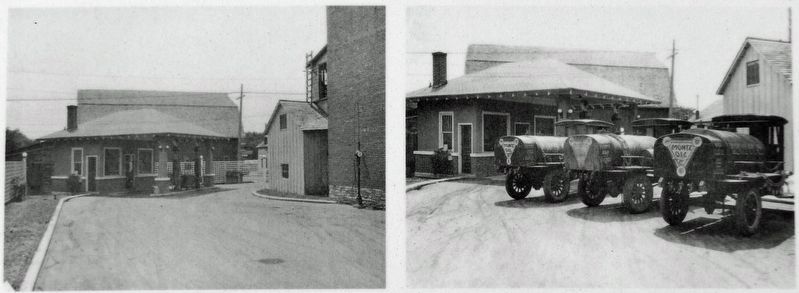
Winneshiek County Historical Society
7. Marker detail: Two views of the Monte Oil Company
A curved driveway allowed entrance on Water Street with exit on State Street. Monte Oil Co. trucks are parked against the building on the corner of Water and State Streets. The 201 E. Water property now occupies the site of the Monte Oil Co.
The building at 205 E. Water housed one of the city's first bakeries in 1850, the year after Decorah was founded. After a long run as a bakery, a paint and wallpaper business was opened in 1899, a quilting company in 1915, and an auto supply business before the building was razed to make room for the Scott Oil Company. 203 E. Water St. housed Charles McKinney's windmill shop, but was also removed to make room for the drive into the Monte Oil Co. station, later known as the Scott Oil Co.
201 and 203 E. Water Street housed a business that marked a transition of another kind. The Service Company operated by Edward R. Pauline and Pearle Ellsworth Bradrick installed indoor bathrooms in homes built before indoor plumbing was common. Previously, hand pumps brought water into the house, and outhouses functioned as bathroom facilities. The city council voted to install city water and sewer in 1881 and Decorah took another progressive step forward.
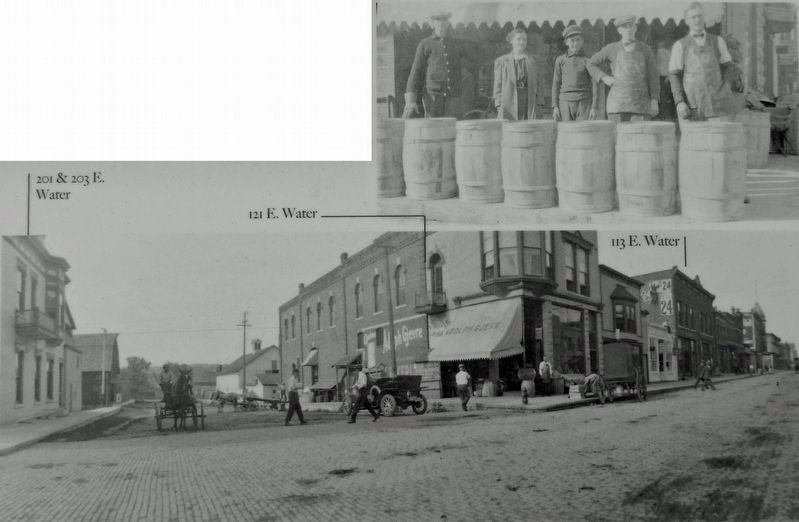
Winneshiek County Historical Society
8. Marker detail: Gjevre Grocery Store
Two views of the Gjevre Grocery Store at 121 E. Water Street. Barrels containing various products are arrayed on the sidewalk. John Slack's Business College was located above the grocery store. A worker applies a poster to the east wall of 113 E. Water Street advertising an August 24 event. Another school, the Valders School of Business, was located in this building on the second floor.
A Grocery Store and Two Schools
121 E. Water Street across the street west from where you are standing is one of the oldest buildings in the business district. Constructed with a brick façade and limestone walls on the west side, it has a pressed-metal cornice and detailing on the north façade and corner, arched brick hood molds and keystones as well as decorative brick cornice work on the east side, with an Italianate style overall. Earliest records of ownership date to September of 1864 with the A.B. Anderson shoe store at this location. A Mr. Ward is recorded as keeping his racehorses in the building's basement. The Decorah Business College run by John R. Slack was begun circa 1874 on the second floor. Slack was an experienced accountant and operated the business college in cooperation with the Decorah institute which was administered by John Breckenridge.
The building was a saloon in 1894 but served for most of its
life as a grocery store. The grocery store was owned and managed by a number of different people including Adolph Gjevre, George P. Ode, Gustave N. Kjome, O.J. Ness, and Mr. and Mrs. Utz Henning among others. Norton Kjome operated a hardware store following its time as a grocery store with a tavern as the next business occupying the building.
Another school, the Valders School of Business, was operated from the second floor of 113 E. Water Street just a few doors down from the Decorah Business College. Charles H. Valders started the business college in 1888 after 13 years of teaching in the public schools and at Luther College. Later the school also included a normal training department that prepared students for teaching. A growing enrollment necessitated moving the business department to the upper floor of a building on the northeast corner of Main and Washington Streets. Before the school closed in 1922, several thousand students attended with as many as 400 in attendance during a given year.
[other photo captions]
• A photo taken c. 1900 shows a garage, the Goodrich Tire Shop and a log house. The second photo taken c. 1910 shows the first two buildings combined into Hoyt's Garage with the Lincoln Cigar Company on the right. B.M. Graham Feed Barn entrance is on the left of the photo.Funding for this sign provided by: Downtown Decorah Betterment
• The Commercial Hotel burned down on Easter Sunday, April 1, 1951. Three local hotel residents perished in the blaze.
• An exterior view and an interior view of the Goodrich Tire Shop at 211 E. Water Street. The sign on the building advertises their vulcanization process. Willy Branhagen is shown vulcanizing tires in the photo of the interior.
• The Monte Oil Co. was a local business and sponsored a contest to name their own brand of gasoline. Go-Phar was the winning epithet with the resulting logo featuring a gopher on stilts.
• A 1925 postcard advertising the Monte Oil Co. products. There was a push to “buy locally” at that time, too.
Topics. This historical marker is listed in these topic lists: Architecture • Education • Industry & Commerce • Settlements & Settlers.
Location. 43° 18.246′ N, 91° 47.07′ W. Marker is in Decorah, Iowa, in Winneshiek County. Marker is at the intersection of East Water Street and State Street, on the left when traveling west on East Water Street. The marker is located along the sidewalk near the southeast corner of the intersection. Touch for map. Marker is at or near this postal address: 201 East Water Street, Decorah IA 52101, United States of America. Touch for directions.
Other nearby markers. At least 8 other markers are within walking distance of this marker. A different marker also named Decorah: A Walk into the Past (about 300 feet away, measured in a direct line); a different marker also named Decorah: A Walk into the Past (about 300 feet away); a different marker also named Decorah: A Walk into the Past (about 300 feet away); a different marker also named Decorah: A Walk into the Past (about 700 feet away); Winnebago Street (about 800 feet away); a different marker also named Decorah: A Walk into the Past (approx. 0.2 miles away); "The Biggest Day in the History of the County" (approx. 0.2 miles away); a different marker also named Decorah: A Walk into the Past (approx. 0.2 miles away). Touch for a list and map of all markers in Decorah.
Credits. This page was last revised on February 24, 2024. It was originally submitted on February 23, 2024, by Cosmos Mariner of Cape Canaveral, Florida. This page has been viewed 43 times since then. Photos: 1, 2, 3, 4, 5, 6, 7, 8, 9. submitted on February 24, 2024, by Cosmos Mariner of Cape Canaveral, Florida.
